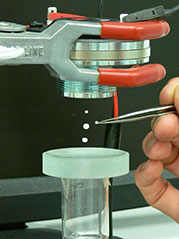Ultrasonic tweezers for life-changing medical advances
Researchers from the Universities of Bristol and Southampton have helped to develop pioneering ‘tweezers’ that use ultrasound beams to grip and manipulate tiny clusters of cells, which could lead to life-changing medical advances, such as better cartilage implants that reduce the need for knee replacement operations.
The team worked with test equipment maker Agilent, Crystapol International, the Defence Science and Technology Laboratory (DSTL), Leica Genetix, Loadpoint, Piezo Composite Transducers (PCT), Weidlinger Associates and IKTS-Fraunhofer.
Using ultrasonic sound fields, cartilage cells taken from a patient’s knee can be levitated for weeks in a nutrient-rich fluid. This means the nutrients can reach every part of the culture’s surface and, combined with the stimulation provided by the ultrasound, enables the cells to grow and to form better implant tissue than when grown on a glass petri dish.
The tweezers, developed with £3.6m of Engineering and Physical Sciences Research Council (EPSRC) funding, involve multiple, tiny beams of ultrasonic waves that, in a typical device, point into a 10 mm-diameter chamber from all around. With the aid of a powerful microscope to monitor the procedure, the forces generated by the waves can then be manipulated so that they nudge cells into the required position, turn them around, or hold them firmly in place. The ‘four year Electronic Sonotweezers: Particle Manipulation with Ultrasonic Arrays’ programme started in 2009 and also includes researchers from the Universities of Dundee and Glasgow.
By holding the cells in the required position firmly but gently, the tweezers can also mould the growing tissue into exactly the right shape so that the implant is truly fit-for-purpose when inserted into the patient’s knee.
“Ultrasonic tweezers can provide what is, in effect, a zero-gravity environment perfect for optimising cell growth,” said Professor Martyn Hill, Head of the Engineering Sciences Unit at the University of Southampton, who led the cartilage tissue engineering work in collaboration with colleagues Dr Peter Glynne-Jones, New Frontiers Fellow in Engineering Sciences, Dr Rahul Tare, a Lecturer in Musculoskeletal Science and Bioengineering, and Professor Richard Oreffo, a Professor of Musculoskeletal Science. “As well as levitating cells, the tweezers can make sure that the cell agglomerates maintain a flat shape ideal for nutrient absorption. They can even gently massage the agglomerates in a way that encourages cartilage tissue formation.”
Professor Bruce Drinkwater of Bristol University, who co-ordinated the programme, said: “Ultrasonic tweezers have all kinds of possible uses in bioscience, nanotechnology and more widely across industry. They offer big advantages over optical tweezers relying on light waves and also over electromagnetic methods of cell manipulation; for example, they have a complete absence of moving parts and can manipulate not just one or two cells at a time but clusters up to 1mm across – a scale that makes them very suitable for applications like tissue engineering.”
The research programme has also shown that ultrasonic tweezers can be used to build up cell tissue layer by layer, which could for instance, help to reconstruct nerve tissue after severe trauma such as limb amputation.
This research will enable ultrasonic tweezer technology to be refined and miniaturised and specific uses to be explored and developed in the next few years. The first real-world applications, in sectors such as bioscience and electronics, could potentially be developed within around five years.
http://www.bristol.ac.uk/physics/research/nanophysics/facilities/tweezers)
Related articles
Ultrasonic array gives touch feedback for gestures in mid air
A team from the University of Bristol has developed a way to provide feedback from a screen without touching it.
Ultrahaptics in action
The team from the University of Bristol’s Interaction and Graphics (BIG) research group has used a phased array of ultrasonic transmitters to focus high frequency sound onto a target in mid-air. This would be used to provide positive feedback for a gesture-based user interface.
The research paper, to be presented at the ACM Symposium on User Interface Software and Technology (UIST) 2013 by Tom Carter from the Department of Computer Science, will unveil UltraHaptics, using ultrasonic vibrations for the first time to deliver tactile sensations to the user. The ultrasonic transducer array emits very high frequency sound waves that can be steered by changing the phase. When all of the sound waves meet at the same location at the same time, they create sensations on a human’s skin.
By carrying out technical evaluations, the team have shown that the system is capable of creating individual points of feedback that are far beyond the perception threshold of the human hand. The researchers have also established the necessary properties of a display surface that is transparent to 40kHz ultrasound.
The results from two user studies have demonstrated that feedback points with different tactile properties can be distinguished at smaller separations. The researchers also found that users are able to identify different tactile properties with training.
Finally, the research team explored three new areas of interaction possibilities that UltraHaptics can provide: mid-air gestures, tactile information layers and visually restricted displays, and created an application for each. Tom Carter, PhD student in the Department of Computer Science’s BIG research group, said: “Current systems with integrated interactive surfaces allow users to walk-up and use them with bare hands. Our goal was to integrate haptic feedback into these systems without sacrificing their simplicity and accessibility.
“To achieve this, we have designed a system with an ultrasound transducer array positioned beneath an acoustically transparent display. This arrangement allows the projection of focused ultrasound through the interactive surface and directly onto the users’ bare hands. By creating multiple simultaneous feedback points, and giving them individual tactile properties, users can receive localised feedback associated to their actions.”



















